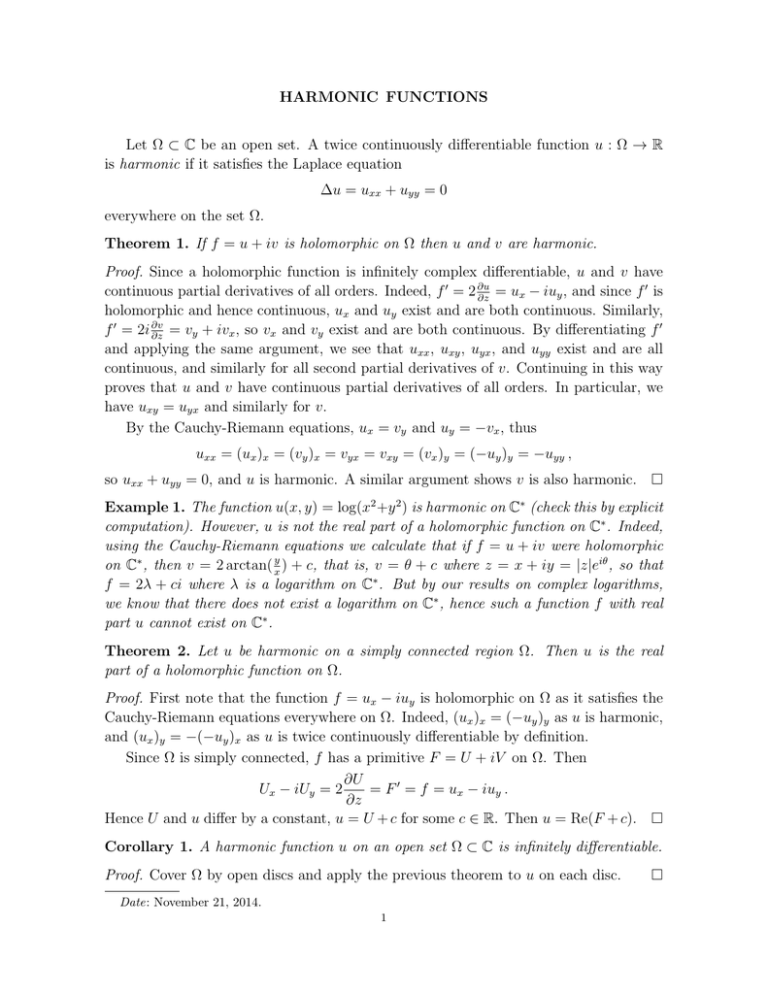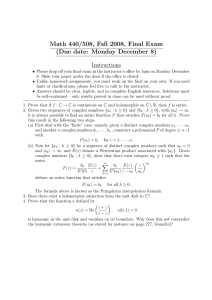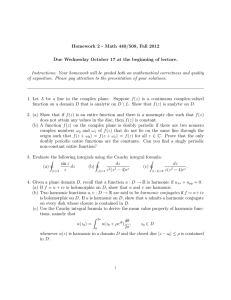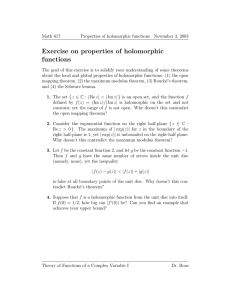HARMONIC FUNCTIONS Let Ω C C be an open set. A twice
advertisement

HARMONIC FUNCTIONS Let Ω ⊂ C be an open set. A twice continuously differentiable function u : Ω → R is harmonic if it satisfies the Laplace equation ∆u = uxx + uyy = 0 everywhere on the set Ω. Theorem 1. If f = u + iv is holomorphic on Ω then u and v are harmonic. Proof. Since a holomorphic function is infinitely complex differentiable, u and v have continuous partial derivatives of all orders. Indeed, f 0 = 2 ∂u = ux − iuy , and since f 0 is ∂z holomorphic and hence continuous, ux and uy exist and are both continuous. Similarly, f 0 = 2i ∂v = vy + ivx , so vx and vy exist and are both continuous. By differentiating f 0 ∂z and applying the same argument, we see that uxx , uxy , uyx , and uyy exist and are all continuous, and similarly for all second partial derivatives of v. Continuing in this way proves that u and v have continuous partial derivatives of all orders. In particular, we have uxy = uyx and similarly for v. By the Cauchy-Riemann equations, ux = vy and uy = −vx , thus uxx = (ux )x = (vy )x = vyx = vxy = (vx )y = (−uy )y = −uyy , so uxx + uyy = 0, and u is harmonic. A similar argument shows v is also harmonic. Example 1. The function u(x, y) = log(x2 +y 2 ) is harmonic on C∗ (check this by explicit computation). However, u is not the real part of a holomorphic function on C∗ . Indeed, using the Cauchy-Riemann equations we calculate that if f = u + iv were holomorphic on C∗ , then v = 2 arctan( xy ) + c, that is, v = θ + c where z = x + iy = |z|eiθ , so that f = 2λ + ci where λ is a logarithm on C∗ . But by our results on complex logarithms, we know that there does not exist a logarithm on C∗ , hence such a function f with real part u cannot exist on C∗ . Theorem 2. Let u be harmonic on a simply connected region Ω. Then u is the real part of a holomorphic function on Ω. Proof. First note that the function f = ux − iuy is holomorphic on Ω as it satisfies the Cauchy-Riemann equations everywhere on Ω. Indeed, (ux )x = (−uy )y as u is harmonic, and (ux )y = −(−uy )x as u is twice continuously differentiable by definition. Since Ω is simply connected, f has a primitive F = U + iV on Ω. Then ∂U Ux − iUy = 2 = F 0 = f = ux − iuy . ∂z Hence U and u differ by a constant, u = U + c for some c ∈ R. Then u = Re(F + c). Corollary 1. A harmonic function u on an open set Ω ⊂ C is infinitely differentiable. Proof. Cover Ω by open discs and apply the previous theorem to u on each disc. Date: November 21, 2014. 1 Example 2. Let u(x, y) = x − ex sin(y) on C. Then u is harmonic (check!), and since C is simply connected there exists an entire function F = u + iv such that Re(F ) = u. By the Cauchy-Riemann equations we have vx = −uy = ex cos(y) , so vy = ux = 1 − ex sin(y) , so v = ex cos(y) + function of y , v = y + ex cos(y) + function of x . Combining these constraints we see that we may take v = y + ex cos(y) and then F (z) = F (x, y) = (x + iy) + (−ex sin(y) + iex cos(y)) = z + iez . Let u, v : Ω → R be harmonic, where Ω ⊂ C is open. If u + iv is holomorphic then we say that v is a harmonic conjugate for u on Ω. If v1 , v2 are both harmonic conjugates for u on Ω, then (u+iv1 )−(u+iv2 ) = i(v1 −v2 ) is the difference of two holomorphic functions and is hence holomorphic. But i(v1 − v2 ) only takes purely imaginary values, so the image of Ω lies within the imaginary axis and cannot be an open set. If Ω is connected then by the open mapping theorem, i(v1 − v2 ) is therefore a (purely imaginary) constant. Thus any two harmonic conjugates on a region differ by a real constant. Theorem 3 (Mean value theorem for holomorphic functions). Let f : DR (z0 ) → C be holomorphic. Then Z 2π 1 f (z0 ) = f (z0 + reiθ )dθ 2π 0 for all 0 < r < R. Proof. 1 f (z0 ) = 2πi Z |z−z0 |=r 1 f (z) dz = z − z0 2πi Z 0 2π f (z0 + reiθ ) iθ rie dθ . reiθ Theorem 4 (Mean value theorem for harmonic functions). If u : DR (z0 ) → R is harmonic then Z 2π 1 u(z0 + reiθ )dθ u(z0 ) = 2π 0 for all 0 < r < R. Proof. Find a holomorphic function f : DR (z0 ) → C such that u = Re(f ). Apply the mean value theorem for holomorphic functions to f and take the real part of both sides. Theorem 5 (Identity theorem for harmonic functions). Let u be harmonic on a region Ω ⊂ C. If u = 0 at every point of a nonempty open subset U ⊂ Ω then u = 0 at every point of Ω. Proof. Consider the holomorphic function f = ux − iuy on Ω. Since f = 0 on U , f = 0 on all of Ω by the identity theorem for holomorphic functions. Hence u is constant. Note that the hypothesis that the harmonic function u vanishes on an open subset U ⊂ Ω is stronger than was required in the identity theorem for holomorphic functions. 2 For an example showing the stronger hypothesis is required, consider the harmonic function u(x, y) = y, which vanishes on the real axis y = 0, but does not vanish identically on all of C. Theorem 6 (Maximum and minimum principle for harmonic functions). If u is a nonconstant harmonic function in a region Ω ⊂ C then u has no maxima or minima in Ω. Proof. Let c ∈ Ω and find > 0 such that D (c) ⊂ Ω. There is a holomorphic function f on D (c) such that Re(f ) = u. By the identity theorem for harmonic functions, f is not constant on D (c) (otherwise u would also be constant on D (c) and hence constant on Ω by the identity theorem for harmonic functions). Hence f (D (c)) is an open set by the open mapping theorem, and then u takes both larger and smaller values than u(c) in D (c). For details of the Poisson integral formula and the solution of the Dirichlet problem on the unit disc, please download the set of handwritten supplementary notes available on the course website. 3







